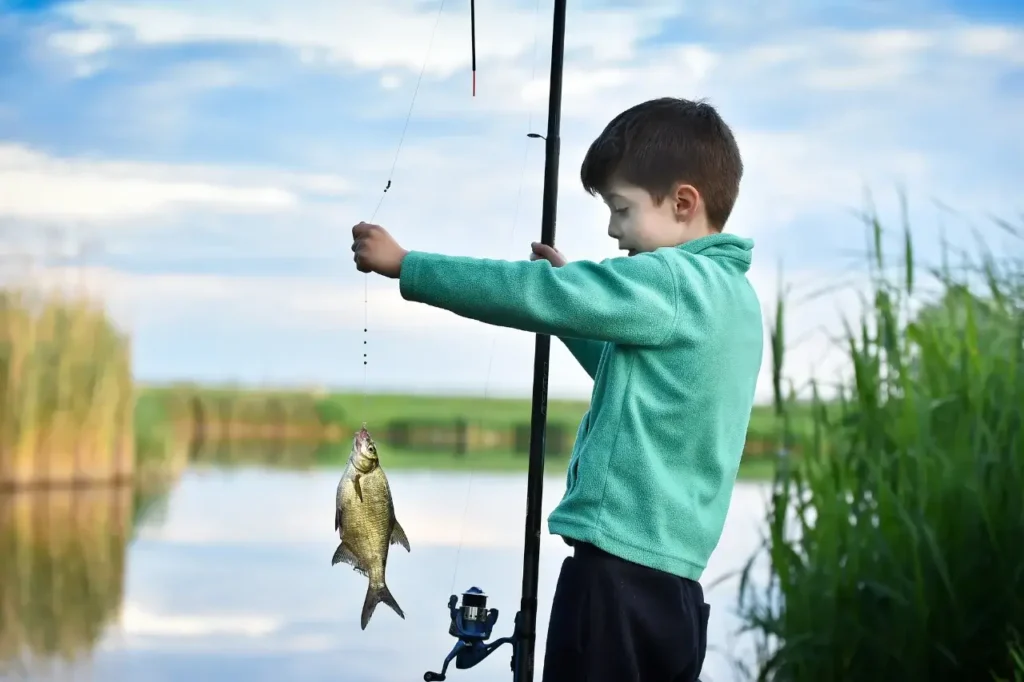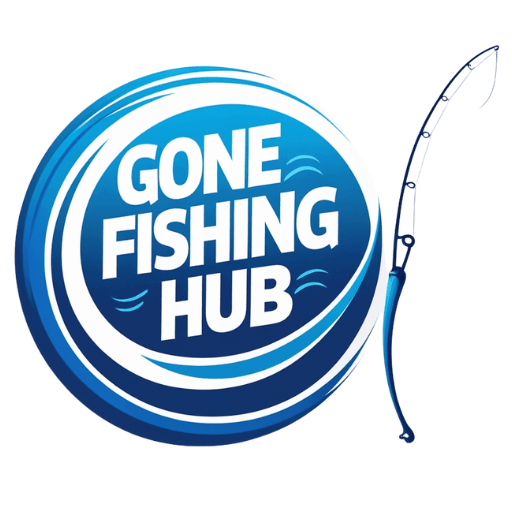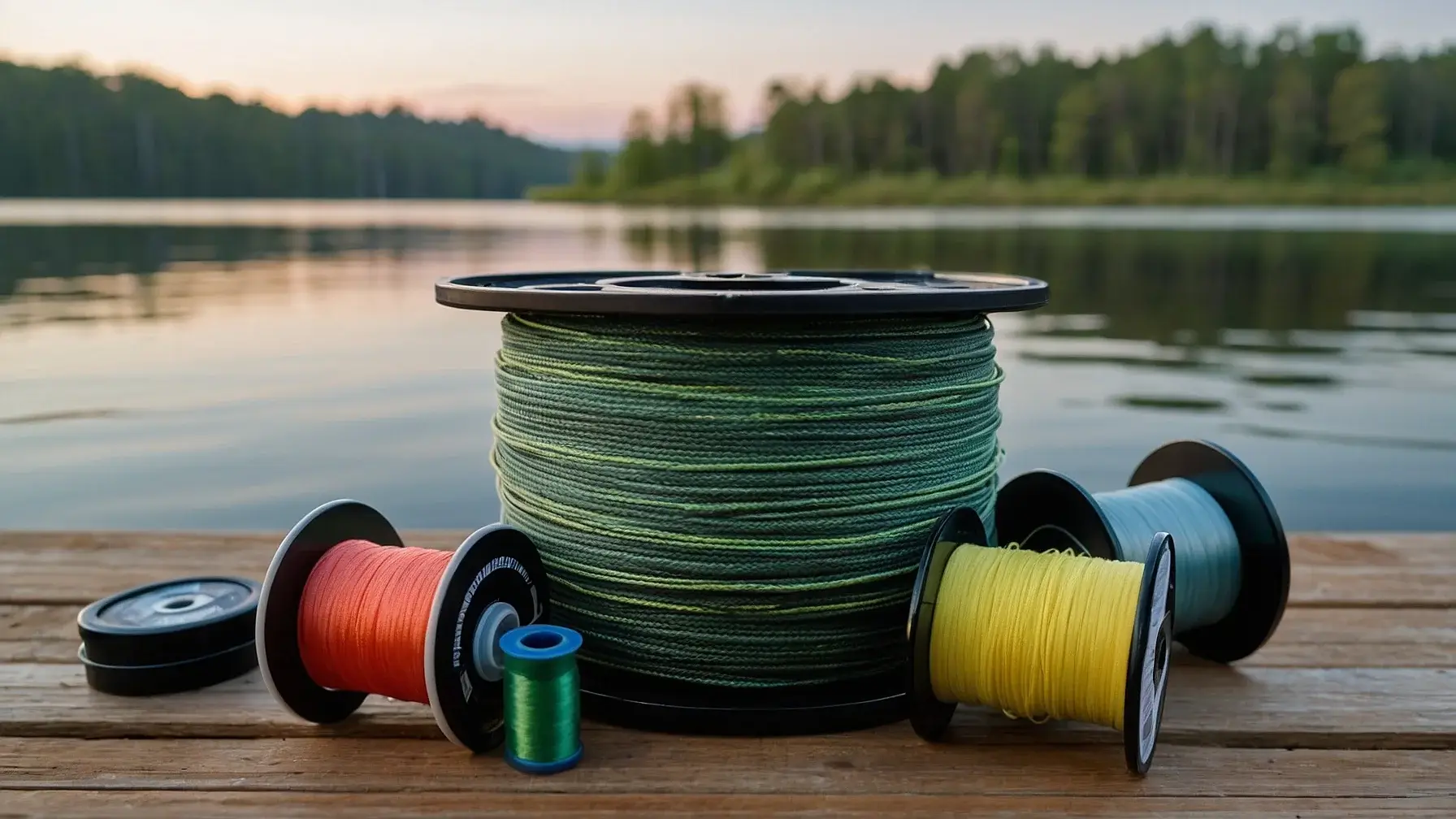Why Choosing the Right Fishing Line Matters 🎣
The Importance of Picking the Right Fishing Line
Your fishing line is as crucial as your rod and reel for a successful fishing trip. Choosing between a braided and fluorocarbon fishing line can determine whether you land your catch or lose it. Whether targeting bass, casting in saltwater, or using a spinning reel, understanding the differences between braided and fluorocarbon fishing lines is essential.
Why Does the Fishing Line Matter So Much?
The type of fishing line you use affects every aspect of your fishing performance:
✅ Casting distance and accuracy – The right line can maximize your reach.
✅ Lure visibility underwater – Some lines are nearly invisible, while others stand out.
✅ Sensitivity to bites – A more sensitive line helps detect even the most subtle strikes.
✅ Performance in different conditions – Some fishing lines work best in clear water, while others excel in deep water or heavy cover.
Imagine making the perfect cast, only to have your line snap under pressure. Or missing a fish because your line stretched too much. That’s why choosing between braided vs fluorocarbon fishing line is crucial.
Braided vs Fluorocarbon Fishing Line: Which One is Better?
There’s no single “best” fishing line—it all depends on:
✔️ The type of fishing you’re doing (bass fishing, finesse fishing, or saltwater fishing)
✔️ Your fishing reel setup (spinning reel, bait caster, or conventional reel)
✔️ The water conditions (clear vs murky, shallow vs deep)
Key Differences:
🔹 Braided fishing line – Known for high strength, zero stretch, and durability.
🔹 Fluorocarbon fishing line – Praised for its near invisibility, sensitivity, and abrasion resistance.
Which one should you choose? That’s exactly what this guide will help you determine! 🚀
What You’ll Learn in This Guide:
This in-depth fishing line comparison will cover the following:
✅ Pros and cons of braided fishing line
✅ Pros and cons of fluorocarbon fishing line
✅ Best fishing line for spinning reels
✅ Fluorocarbon vs monofilament: Key differences
✅ Best fishing line for bass fishing and saltwater fishing
By the end of this guide, you’ll know exactly which fishing line to use for your specific fishing style and conditions. 🎣
Are you ready to choose the best fishing line for your needs? Let’s dive in!
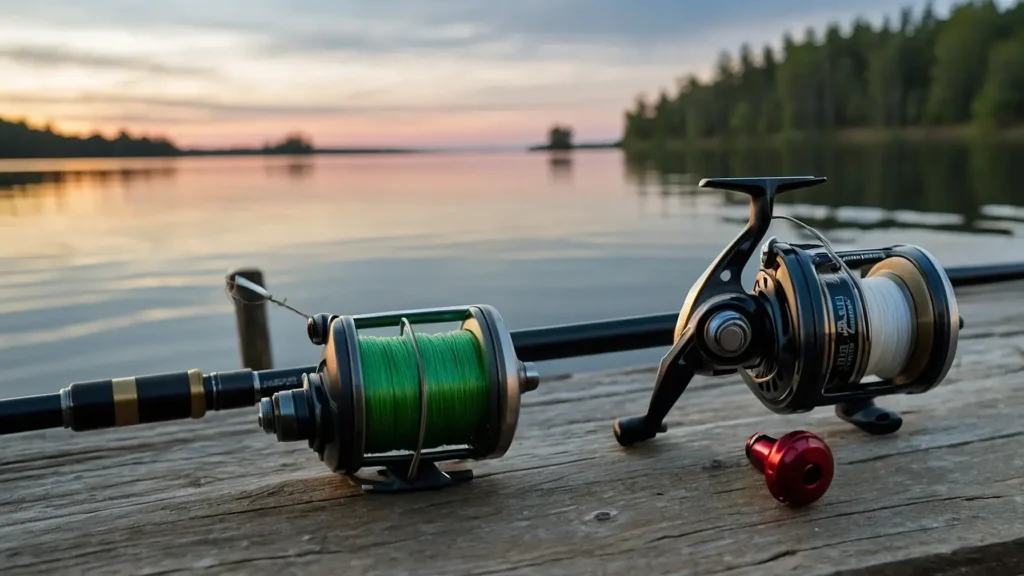
Pairing the right fishing line with your rod and lures is crucial; check out our fishing gear checklist for must-have accessories.
Braided vs Fluorocarbon Fishing Line: Key Differences 🎣
Which Fishing Line is Right for You?
Choosing the best fishing line is a game-changer for anglers. The debate over braided vs fluorocarbon fishing line continues, as each type has distinct advantages that cater to different fishing styles, reel setups, and water conditions. Whether using a spinning reel, fishing in saltwater, or targeting bass, selecting the right fishing line can significantly impact your catch rate and overall fishing experience.
📌 What is a Braided Fishing Line?
A braided fishing line is made from woven synthetic fibers such as Dyneema or Spectra, making it incredibly strong for its diameter. It has zero stretch, which maximizes sensitivity and bite detection.
✅ Key Features of Braided Fishing Line:
✔️ High strength-to-diameter ratio – Stronger line without bulk.
✔️ No stretch – Delivers ultimate sensitivity for detecting bites.
✔️ Floats on water – Ideal for topwater lures and long-distance casting.
✔️ Highly durable – Resistant to wear, making it excellent for saltwater fishing and heavy cover fishing.
💡 Best Uses for Braided Line:
✅ Fishing in heavy cover (weeds, rocks, submerged structures)
✅ Long-distance casting (especially with a spinning reel)
✅ Saltwater fishing, where durability and strength are crucial
⚡ Pro Tip: Pair braided fishing line with a fluorocarbon leader for better invisibility while maintaining strength.
📌 What is a Fluorocarbon Fishing Line?
A fluorocarbon fishing line is made from polyvinylidene fluoride (PVDF), a dense material that makes the line nearly invisible underwater. It has low stretch, improving sensitivity while still providing some shock absorption. Unlike braid, fluorocarbon sinks, making it excellent for deep-water fishing.
✅ Key Features of Fluorocarbon Fishing Line:
✔️ Nearly invisible underwater – Perfect for clearwater fishing.
✔️ Low stretch – Provides a balance between sensitivity and flexibility.
✔️ Sinks faster than braid – Ideal for deep-water fishing techniques.
✔️ Abrasion-resistant – Great for fishing around rocks, docks, and cover.
💡 Best Uses for Fluorocarbon Line:
✅ Bass fishing, especially for finesse techniques (drop shotting, jigging)
✅ Fishing in clear water, where stealth is essential
✅ Leader material for braided setups, improving invisibility
⚡ Pro Tip: Fluorocarbon is an excellent choice for deep-diving crankbaits, soft plastics, and bottom rigs, as it naturally sinks.
⚖️ Side-by-Side Comparison: Braided vs Fluorocarbon Fishing Line
| Feature | Braided Line 🎣 | Fluorocarbon Line 🐠 |
|---|---|---|
| Strength & Durability | ✅ Extremely strong and long-lasting | ✅ Abrasion-resistant but weaker than braid |
| Stretch | ❌ No stretch (ultra-sensitive) | ✅ Low stretch (good balance) |
| Visibility | ❌ Visible in clear water | ✅ Nearly invisible underwater |
| Best for Reels | Best for spinning reels & bait casters | Works well on bait casters & as leader material |
| Best for Fishing Style | Topwater lures, long casts, saltwater | Bass fishing, finesse techniques, clear water |
| Knot Strength | ❌ Harder to tie knots | ✅ Holds knots well |
⚡ Quick Tip: If you want the best of both worlds, use a braided mainline with a fluorocarbon leader—this setup combines strength, casting ability, and invisibility.
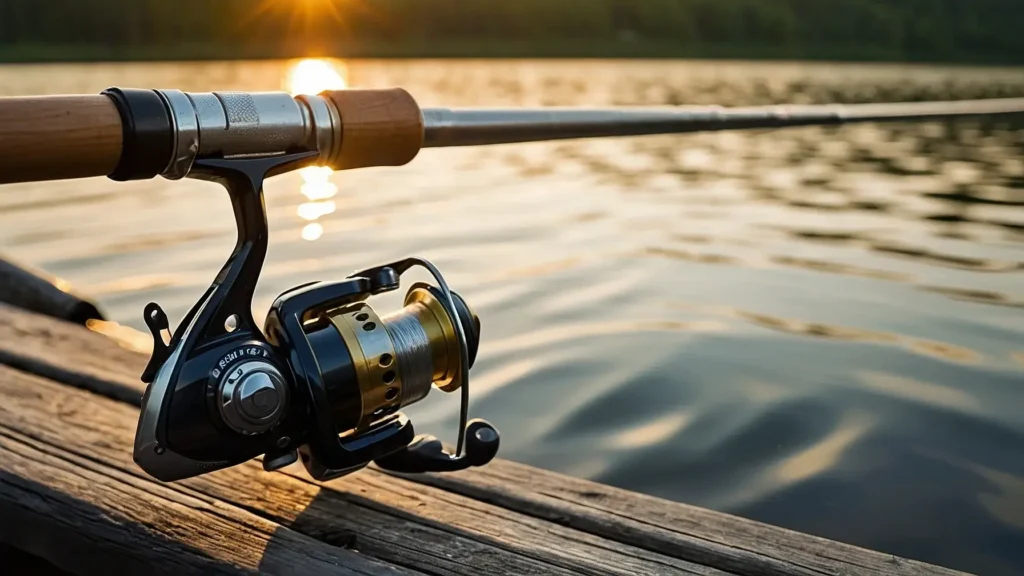
Pros and Cons of Braided Fishing Line 🎣
Why Choose Braided Fishing Line?
A braided fishing line is a top choice for anglers who need maximum strength, sensitivity, and durability. Whether casting long distances, fishing in heavy cover, or using a spinning reel, this line type provides significant advantages. However, it’s not always the best option in every fishing situation. Let’s explore the pros and cons of a braided fishing line to help you determine if it’s the right choice for your next fishing trip.
✅ Pros of Braided Fishing Line
💪 Superior Strength and Durability
✔️ High strength-to-diameter ratio – Braid is significantly stronger than monofilament and fluorocarbon of the same diameter.
✔️ Abrasion-resistant – Ideal for heavy cover fishing, as it withstands friction against rocks, weeds, and submerged structures.
✔️ Excellent for saltwater fishing – Its resistance to corrosion makes it perfect for harsh marine environments.
🎯 No Stretch = Maximum Sensitivity
✔️ Zero stretch allows you to feel even the subtlest bites, improving reaction time when setting the hook.
✔️ Perfect for bass fishing and deep-water fishing, where detecting light nibbles is crucial.
🚀 Long-Distance Casting
✔️ Thin diameter allows for longer and smoother casts than monofilament.
✔️ Works exceptionally well on spinning reels, reducing friction and increasing casting accuracy.
✔️ Great for surf fishing and open-water fishing, where long-distance casts matter.
🛠 Long-Lasting Performance
✔️ UV-resistant – Unlike monofilament, braid doesn’t degrade from sun exposure.
✔️ Long lifespan—It can last 2-3 years before needing replacement, making it a cost-effective choice in the long run.
❌ Cons of Braided Fishing Line
👀 Highly Visible in ClearWater
✔️ Fish can easily detect a braided line, especially in crystal-clear lakes and rivers.
✔️ Solution? Use a fluorocarbon leader for invisibility while maintaining the braid’s strength.
🔗 Difficult to Tie Knots
✔️ Slick and non-stretchy texture makes knots harder to secure.
✔️ Solution? Use Palomar, Double Uni, or FG knots for stronger, slip-proof connections.
🔊 May Dig into the Reel
✔️ Braid can dig into itself under extreme pressure on baitcasting reels, leading to tangles and backlash.
✔️ Solution? Use a monofilament backing before spooling the braid onto your reel.
💲 More Expensive Than Monofilament
✔️ Higher upfront cost compared to monofilament fishing line.
✔️ However, its durability offsets the price, as it lasts longer without frequent replacements.
⚖️ Is Braided Fishing Line Right for You?
✅ Best for:
✔️ Bass fishing in heavy cover (grass, logs, rocks, and lily pads)
✔️ Saltwater fishing, where strength and durability matter
✔️ Long-distance casting (great for surf fishing, pier fishing, and finesse techniques)
✔️ Spinning reels, improving casting performance and reducing friction
❌ Not ideal for:
❌ Clearwater fishing (unless using a fluorocarbon leader)
❌ Beginners, as knot tying can be challenging
❌ Situations where stretch is beneficial, such as trout fishing or shock absorption techniques
⚡ Quick Tip: Want the benefits of braid without its visibility issue? Try a braid-to-fluorocarbon setup with a fluorocarbon leader for stealth and strength!
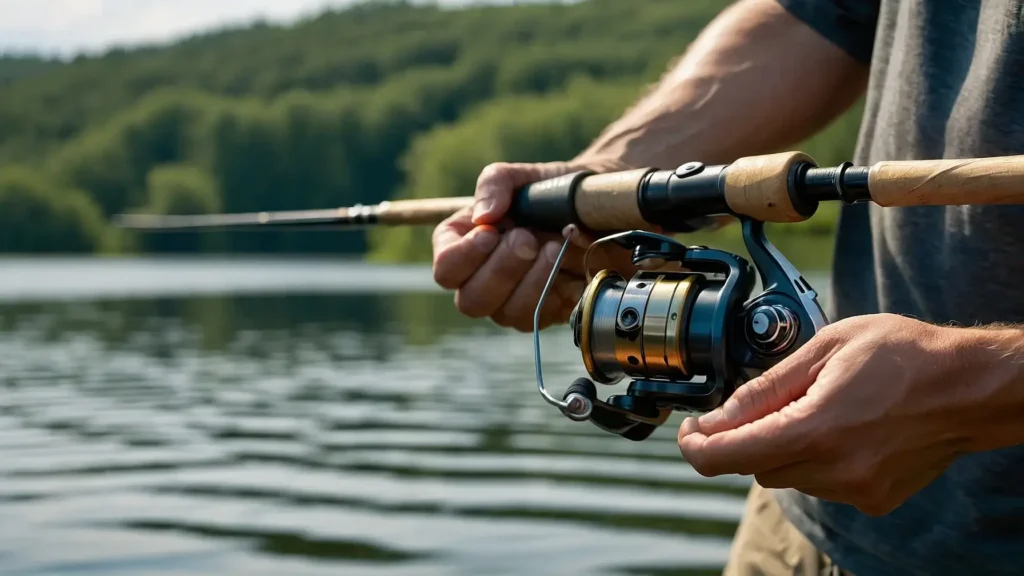
When using different lures, understanding the best fishing lures for bass in summer can give you a competitive edge.
Pros and Cons of Fluorocarbon Fishing Line 🎣
Is Fluorocarbon Fishing Line the Right Choice?
A fluorocarbon fishing line is widely used for its near-invisibility underwater, high sensitivity, and abrasion resistance. But does it work in all fishing situations? While it excels in clearwater fishing, finesse techniques, and leader setups, it also has some drawbacks. Let’s explore the pros and cons of a fluorocarbon fishing line to determine if it’s the right choice for your fishing style.
✅ Pros of Fluorocarbon Fishing Line
👀 Nearly Invisible in Water
✔️ Fluorocarbon has a refractive index close to water, making it nearly invisible to fish.
✔️ Perfect for stealthy presentations in clear lakes, rivers, and saltwater fishing.
✔️ Best for Bass fishing, trout fishing, and highly pressured waters where fish are line-shy.
🎣 Low Stretch = High Sensitivity
✔️ Fluorocarbon has less stretch than monofilament, meaning you feel even the lightest bites.
✔️ Ideal for finesse fishing techniques, such as drop shotting, jigging, and soft plastic presentations.
✔️ Enhances bite detection, improving hook-setting accuracy.
💪 Excellent Abrasion Resistance
✔️ Stronger than monofilament when rubbing against rocks, logs, and underwater structures.
✔️ Best choice for bass fishing near rocky shorelines, dock pilings, or submerged trees.
✔️ Great for saltwater fishing, where durability against reef structures is crucial.
🌊 Sinks Faster Than Braid or Mono
✔️ Unlike braided fishing line, fluorocarbon sinks naturally, making it ideal for deep-water fishing.
✔️ Works exceptionally well with crankbaits, jigs, Carolina rigs, and soft plastics.
✔️ Helps get lures deeper faster, making it great for bottom-feeding fish.
❌ Cons of Fluorocarbon Fishing Line
💲 More Expensive Than Other Line Types
✔️ Fluorocarbon fishing lines cost more than monofilament and even some braided lines.
✔️ Solution? Use fluorocarbon as a leader with a braided mainline to save money while maintaining stealth.
🎭 Can Be Stiff and Hard to Manage
✔️ Fluorocarbon is stiffer than monofilament, making it harder to spool onto spinning reels.
✔️ Lower-quality fluorocarbon lines may have memory issues, leading to coiling and tangling.
✔️ Solution? Choose a high-quality fluorocarbon line designed for spinning reels or soak it in warm water before spooling.
🔗 Knot Strength Can Be Weak
✔️ Fluorocarbon is slicker than monofilament, meaning knots may slip if not tied correctly.
✔️ Solution: For better reliability, use strong fluorocarbon knots such as the Palomar knot, San Diego Jam knot, or Double Uni knot.
⚖️ Is Fluorocarbon Fishing Line Right for You?
✅ Best for:
✔️ Clearwater fishing, where stealth matters.
✔️ Finesse fishing techniques, such as drop shotting and light tackle fishing.
✔️ Bass fishing and saltwater fishing, especially near rocks, reefs, and cover.
✔️ As a leader material for braided fishing line setups.
❌ Not ideal for:
❌ Beginners, as fluorocarbon is stiff and can be harder to handle.
❌ Spinning reels, unless you choose a soft fluorocarbon designed for them.
❌ Topwater lures because fluorocarbon sinks, making it harder to keep lures afloat.
⚡ Quick Tip: If you want the benefits of fluorocarbon without dealing with its downsides, try fluorocarbon leaders instead of spooling an entire reel with it!
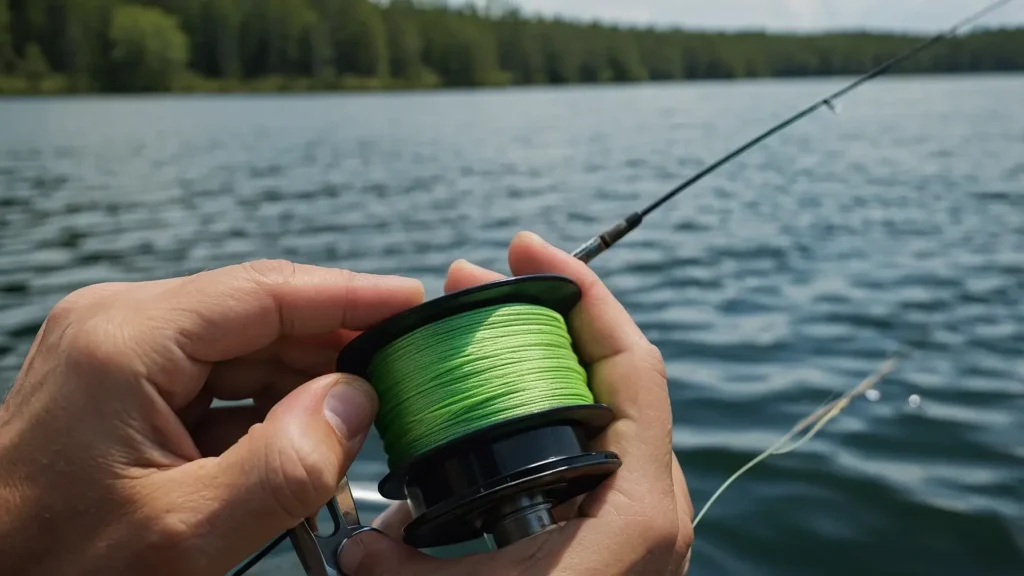
Best Fishing Lines for Spinning Reels: Which One Should You Use? 🎣
Why Choosing the Right Fishing Line for Spinning Reels Matters
Spinning reels are among the most versatile and beginner-friendly fishing setups, but the type of fishing line you spool onto them can significantly affect your performance. The wrong fishing line can cause tangles, line twists, poor casting distance, or weak knots. On the other hand, the right fishing line enhances casting accuracy, lure presentation, and overall success in bass fishing, saltwater fishing, and finesse techniques.
So, which fishing line is best for spinning reels? Should you use braid, fluorocarbon, or monofilament? Let’s compare the three and find the best fishing line for spinning reels!
📌 Best Fishing Line Types for Spinning Reels
✅ Monofilament: Best for Beginners
✔️ Easy to handle, affordable, and holds knots well.
✔️ Moderate stretch helps absorb sudden fish movements, reducing the chance of losing a fish.
✔️ Best for: Casual fishing, topwater lures, and light tackle setups.
❌ Less sensitive than fluorocarbon or braided fishing line.
❌ Shorter casting distance compared to braid.
✅ Braided Line: Best for Long Casts & Sensitivity
✔️ Zero stretch provides maximum sensitivity, helping detect the slightest bites.
✔️ Thin diameter allows for longer, smoother casts on spinning reels.
✔️ Ideal for Saltwater fishing, bass fishing, finesse fishing, and long-distance casting.
❌ Highly visible in clear water – best when paired with a fluorocarbon leader.
✅ Fluorocarbon: Best for Clear Water & Stealth Fishing
✔️ Nearly invisible underwater, making it perfect for finicky fish.
✔️ Abrasion-resistant, making it great for rocky or structure-heavy environments.
✔️ Sinks naturally, making it ideal for deep-water fishing with crankbaits, soft plastics, and jigs.
❌ Can be stiff and prone to memory, leading to line twists on spinning reels.
❌ More expensive than monofilament or braided fishing line.
⚡ Best Setup? Braided Line with a Fluorocarbon Leader!
Many experienced anglers use a braided mainline with a fluorocarbon leader for the best performance on spinning reels.
✅ Why?
✔️ Braided fishing line enhances casting distance & sensitivity.
✔️ Fluorocarbon leader adds invisibility & abrasion resistance.
✔️ This combination works for bass fishing, saltwater fishing, finesse fishing, and deep-water techniques.
⚖️ Comparison Table: Best Fishing Line for Spinning Reels
| Feature | Monofilament 🎣 | Braided Line 🐠 | Fluorocarbon 🦈 |
|---|---|---|---|
| Ease of Use | ✅ Easiest to handle | ❌ Can be tricky for beginners | ❌ Can be stiff and harder to manage |
| Stretch | ✅ Moderate stretch (absorbs shocks) | ❌ No stretch (max sensitivity) | ✅ Low stretch (good sensitivity) |
| Casting Distance | ❌ Shorter than braid | ✅ Excellent casting range | ✅ Good, but stiffer lines can limit distance |
| Visibility | ❌ More visible than fluorocarbon | ❌ Very visible in clear water | ✅ Nearly invisible underwater |
| Durability | ❌ Weaker needs frequent replacement | ✅ Long-lasting & strong | ✅ Abrasion-resistant but prone to memory |
| Best Uses | Topwater lures, beginner setups | Bass fishing, saltwater fishing, finesse fishing | Clearwater fishing, deep-water techniques |
⚡ Quick Tip:
If you’re a beginner, start with monofilament.
If you want better casting distance and sensitivity, go with braid + fluorocarbon leader for the best spinning reel setup.
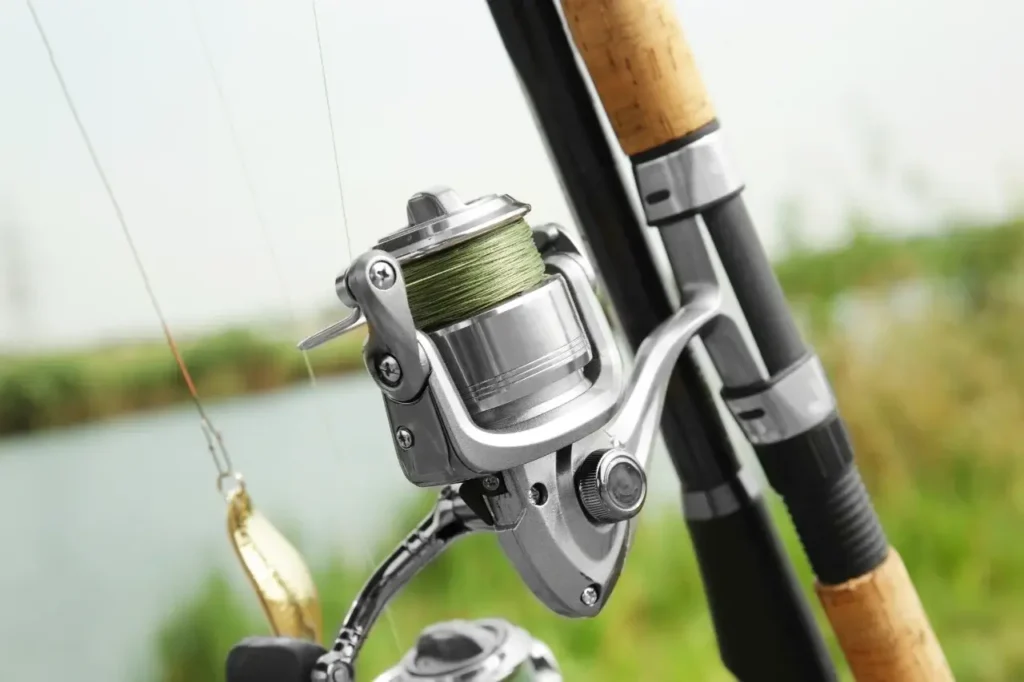
Are you having trouble choosing a rod that complements your line type? Our guide on the best fishing rods for beginners can help.
Fluorocarbon vs Monofilament Fishing Line: What’s the Difference? 🎣
Which Fishing Line Should You Choose?
When it comes to fluorocarbon vs monofilament fishing line, many anglers ask: Which is better? The answer depends on your fishing technique, target species, and water conditions. While monofilament is affordable and beginner-friendly, fluorocarbon offers superior invisibility and durability. Understanding their key differences will help you make the best choice for bass fishing, saltwater fishing, or spinning reels.
📌 What is Monofilament Fishing Line?
✅ Single-strand nylon construction – soft and flexible
✅ Budget-friendly & easy to use – ideal for beginners
✅ Floats on water – perfect for topwater fishing
✅ Stretch factor – absorbs shocks and prevents break-offs
💡 Best for:
✔️ Topwater lures (poppers, buzz baits, frogs)
✔️ Casual fishing or beginner anglers
✔️ Situations where shock absorption is needed
📌 What is a Fluorocarbon Fishing Line?
✅ Made from polyvinylidene fluoride (PVDF) – denser and stronger
✅ Virtually invisible underwater – excellent for clearwater fishing
✅ Low stretch – improves sensitivity and hooksets
✅ Sinks naturally – ideal for deep-water fishing techniques
💡 Best for:
✔️ Clearwater fishing, where fish are line-shy
✔️ Deep-water fishing with crankbaits, jigs, and drop shots
✔️ Leader material for braided setups
⚖️ Fluorocarbon vs Monofilament: Key Differences
| Feature | Fluorocarbon 🎣 | Monofilament 🐟 |
|---|---|---|
| Visibility | ✅ Nearly invisible underwater | ❌ More Visible |
| Stretch | ✅ Low stretch (better sensitivity) | ✅ High stretch (absorbs shocks) |
| Buoyancy | ❌ Sinks (ideal for deep-water fishing) | ✅ Floats (great for topwater lures) |
| Abrasion Resistance | ✅ Stronger against rocks & debris | ❌ Weaker under friction |
| Ease of Use | ❌ Stiffer can have memory issues | ✅ Soft and easy to handle |
| Best Use Cases | ✅ Clearwater, finesse fishing, leaders | ✅ Topwater lures, casual fishing, affordability |
⚡ Quick Tip:
Many experienced anglers combine both using fluorocarbon leaders with monofilament or braided mainline to benefit both fishing lines!
✅ Monofilament for floating lures and topwater action
✅ Fluorocarbon leader for stealth and abrasion resistance
✅ Best of both worlds – sensitivity, invisibility, and easy handling

Best Fishing Lines for Saltwater Fishing: Braid or Fluorocarbon? 🌊🎣
Which Fishing Line is Best for Saltwater?
Saltwater fishing presents unique challenges—strong currents, abrasive reefs, and powerful fish demand a durable and reliable fishing line. The best saltwater fishing line depends on your target species, fishing technique, and water depth.
Two top contenders are braided and fluorocarbon fishing lines, each offering distinct advantages. But which one should you choose? Let’s break it down!
📌 Why Braided Line is Great for Saltwater Fishing
✅ Incredible Strength & Thin Diameter
✔️ High strength-to-diameter ratio – Use thinner line without sacrificing power
✔️ Ideal for long casts, deep-sea fishing, and battling large saltwater species like tarpon or redfish
🚀 Long Casting Distance
✔️ Slick, lightweight braid allows for farther casting – perfect for surf fishing or pier fishing
✔️ Helps reach deep waters when jigging or bottom fishing
🎣 Zero Stretch = Maximum Sensitivity
✔️ Braid has no stretch, making it ultra-sensitive to light bites
✔️ Great for detecting fish nibbling on live bait in deep water
❌ Downsides of Braided Line for Saltwater Fishing
👀 Highly Visible in Clear Water – Fish can see braid easily (Solution: Use a fluorocarbon leader)
🪨 Lacks Abrasion Resistance – Rocks, reefs, and sharp teeth can fray the line
📌 Why Fluorocarbon is a Smart Choice for Saltwater Fishing
✅ Invisible Underwater = More Bites
✔️ Fluorocarbon has a similar refractive index to water, making it nearly invisible
✔️ Perfect for stealthy presentations in clear saltwater
💪 Superior Abrasion Resistance
✔️ Unlike braid, fluorocarbon resists damage from rocks, reefs, and sharp-toothed fish
✔️ Excellent for leader material, providing durability where it matters most
🌊 Sinks Naturally for Deep-Water Fishing
✔️ Unlike braid, fluorocarbon sinks, making it ideal for bottom fishing or jigging
✔️ Works well when targeting snapper, grouper, or deep-sea species
❌ Downsides of Fluorocarbon for Saltwater Fishing
💲 More Expensive Than Braid – But lasts longer with proper care
🎯 Shorter Casting Distance – Thicker diameter reduces casting range compared to braid
⚖️ Braid vs Fluorocarbon: Which One Should You Use?
| Feature | Braided Line 🎣 | Fluorocarbon Line 🐟 |
|---|---|---|
| Strength | ✅ High strength, thinner diameter | ✅ Strong, but thicker |
| Visibility | ❌ Highly visible in clear water | ✅ Nearly invisible underwater |
| Stretch | ❌ No stretch (ultra-sensitive) | ✅ Low stretch (good balance) |
| Durability | ❌ Less abrasion-resistant (needs a leader) | ✅ Resists cuts from rocks and reefs |
| Casting Distance | ✅ Best for long-distance casts | ❌ Shorter casts than braid |
| Best Use Cases | Deep-sea, surf, and long-distance fishing | Clearwater, leader material, bottom fishing |
⚡ Best Setup for Saltwater Fishing?
✅ Braided mainline + Fluorocarbon leader!
✔️ Get the strength and casting ability of braid
✔️ Add stealth and abrasion resistance of fluorocarbon
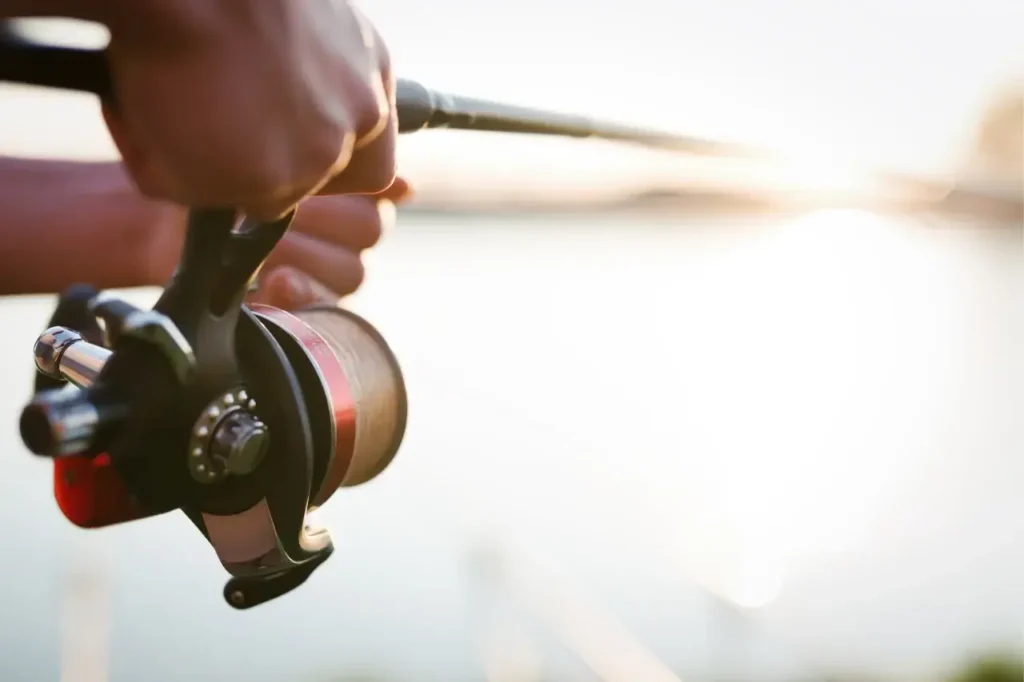
Best Fishing Lines for Bass Fishing: Which Line Gives You an Edge? 🎣
Why Choosing the Right Fishing Line for Bass Fishing Matters
Bass are aggressive, strong fighters and the right fishing line can be the difference between landing a trophy bass and losing it. The best fishing line for bass fishing affects:
✅ Casting distance – A more extended cast can help reach more fish
✅ Lure action – The right line enhances how your bait moves underwater
✅ Hooksets – Sensitivity and stretch impact your ability to secure the hook
So, should you choose braid, fluorocarbon, or monofilament for bass fishing? Let’s break it down!
📌 Best Fishing Line Options for Bass Fishing
✅ Monofilament: Best for Topwater Lures & Beginners
✔️ Floats, making it perfect for topwater lures like poppers and buzz baits
✔️ Stretch absorbs shock, preventing hooks from pulling out of a bass’s mouth
✔️ Affordable & easy to manage – Great for beginner bass anglers
❌ Not as sensitive as fluorocarbon or braided line
✅ Fluorocarbon: Best for Clear Water & Bottom Fishing
✔️ Nearly invisible underwater, making it ideal for stealthy presentations
✔️ Low stretch = stronger hooksets than monofilament
✔️ Sinks naturally, perfect for jigs, crankbaits, and soft plastics
❌ Stiffer than mono, which can cause line memory and knots
✅ Braided Line: Best for Heavy Cover & Strength
✔️ No stretch = Maximum sensitivity – Feel even the lightest bites
✔️ Ultra-strong for pulling bass out of thick weeds, lily pads, and submerged logs
✔️ Great for frog fishing and heavy jigs in dense vegetation
❌ Highly visible in clear water – Best used with a fluorocarbon leader
⚡ Best Setup for Bass Fishing?
✅ Braided line + Fluorocarbon leader!
✔️ Strength & durability from braid
✔️ Stealth & abrasion resistance from fluorocarbon
⚖️ Comparison Table: Best Fishing Line for Bass Fishing
| Feature | Monofilament 🎣 | Fluorocarbon 🐟 | Braided Line ⚡ |
|---|---|---|---|
| Visibility | ❌ More visible | ✅ Nearly invisible | ❌ Highly visible |
| Stretch | ✅ High stretch (shock absorption) | ✅ Low stretch | ❌ No stretch (max sensitivity) |
| Buoyancy | ✅ Floats (best for topwater) | ❌ Sinks (great for deep lures) | ✅ Floats (useful for frogging) |
| Durability | ❌ Wears out faster | ✅ Abrasion-resistant | ✅ Long-lasting |
| Best Use Cases | Topwater baits, beginner setups | Clearwater, finesse fishing, bottom baits | Heavy cover, weed beds, thick structure |
⚡ Quick Tip:
✔️ For clear water, use fluorocarbon
✔️ For thick weeds, go with braid
✔️ For topwater lures, stick with monofilament
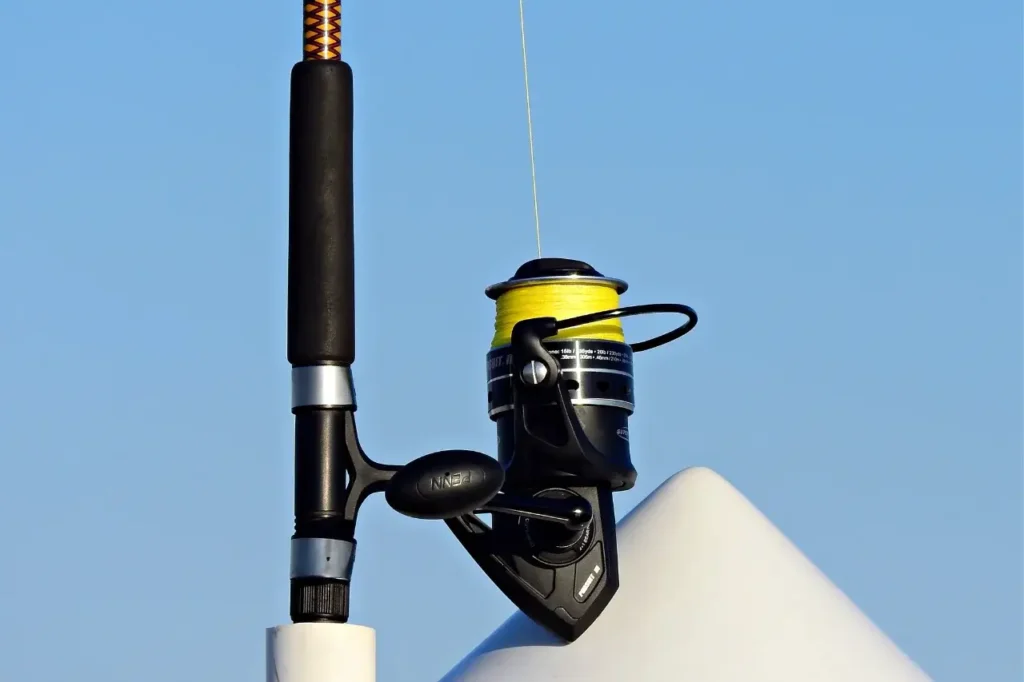
🚀 Final Verdict: Which Fishing Line Should You Choose? 🎣
How to Choose the Perfect Fishing Line?
Choosing the best fishing line can be overwhelming, with so many options available. Should you go with braided, fluorocarbon, or monofilament? Each has advantages and disadvantages, depending on your fishing technique, target species, and water conditions.
This section summarizes all key points to help you make the best choice for your next fishing trip.
📌 Best Fishing Line Based on Fishing Conditions
✅ For Beginners & General Fishing → Monofilament Line
✔️ Easy to handle, less prone to tangles, and easy to tie knots.
✔️ Ideal for topwater lures and casual fishing trips.
✔️ Budget-friendly, making it great for new anglers.
❌ Less sensitive than braid or fluorocarbon.
❌ High stretch, which reduces hook-setting power.
✅ For Clear Water & Stealth Fishing → Fluorocarbon Line
✔️ Nearly invisible underwater – perfect for finicky fish.
✔️ Low stretch = better bite detection and stronger hooksets.
✔️ Abrasion-resistant, great for rocky areas and around structures.
❌ Stiffer than monofilament, which can cause “line memory.”
❌ More expensive than mono and braid.
✅ For Heavy Cover & Power Fishing → Braided Line
✔️ High strength-to-diameter ratio – ultra-strong and thin.
✔️ Zero stretch = maximum sensitivity for detecting light bites.
✔️ Great for long-distance casting and fishing in thick vegetation.
❌ Highly visible in clear water – use with a fluorocarbon leader.
❌ Slick texture – requires specialized knots for secure connections.
⚖️ Final Comparison Table: Which Fishing Line is Right for You?
| Feature | Monofilament 🎣 | Fluorocarbon 🐟 | Braided Line ⚡ |
|---|---|---|---|
| Visibility | ❌ Visible | ✅ Nearly invisible | ❌ Highly visible |
| Stretch | ✅ High (shock absorption) | ✅ Low | ❌ Zero stretch (max sensitivity) |
| Buoyancy | ✅ Floats (best for topwater) | ❌ Sinks (great for deep lures) | ✅ Floats |
| Durability | ❌ Wears out faster | ✅ Abrasion-resistant | ✅ Long-lasting |
| Best Use Cases | Universal fishing, beginners | Clearwater, finesse fishing, bottom baits | Heavy cover, weed beds, long casts |
| Cost | ✅ Affordable | ❌ Expensive | ❌ Expensive |
🔥 Best Overall Setup?
✅ Braided Mainline + Fluorocarbon Leader!
This combination provides the best balance of strength, sensitivity, and invisibility:
✔️ Braid for casting distance & sensitivity.
✔️ Fluorocarbon for invisibility & abrasion resistance.
✔️ Perfect for bass fishing, saltwater fishing, and finesse techniques.
📌 Final Fishing Line Recommendations
✔ For beginners → Start with monofilament unless you plan to fish in harsh conditions.
✔ For clear water → Use fluorocarbon or braid with a fluorocarbon leader.
✔ For fishing in thick cover, → Braided line is your best option.
✔ For deep-water fishing → Fluorocarbon sinks are great for bottom fishing.
✔ For spinning reels → Braided mainline + fluorocarbon leader for the best performance.
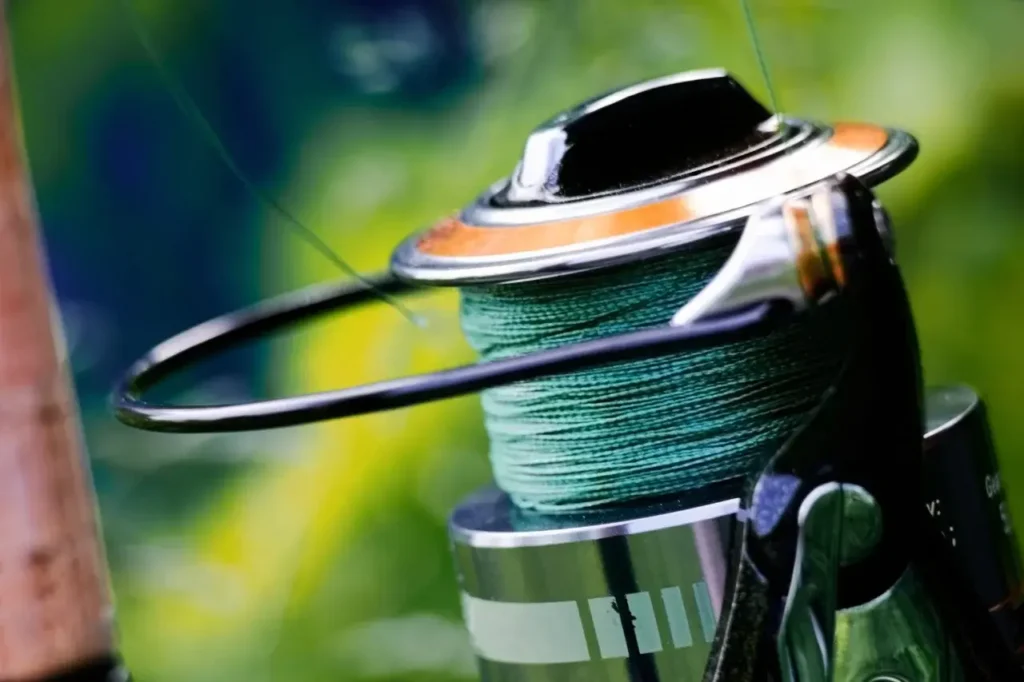
FAQ – Common Questions About Choosing the Right Fishing Line 🎣
Choosing the right fishing line can be confusing, especially with many available options. Below are the most frequently asked questions and expert answers to help you make the best choice for your fishing style, target species, and water conditions.
Which Fishing Line is Best for Beginners?
Monofilament fishing line is the best option for beginners because:
✔️ Easy to handle – Less prone to tangles and more straightforward to tie knots.
✔️ Budget-friendly – More affordable than fluorocarbon and braid.
✔️ Shock absorption – High stretch prevents sudden break-offs.
✔️ Great for topwater lures – Floats, making it ideal for poppers and surface baits.
💡 Best for: Casual fishing, freshwater fishing, and learning basic techniques.
Is Fluorocarbon Better Than Monofilament?
✅ Fluorocarbon is better for:
✔️ Clear water conditions – Nearly invisible underwater.
✔️ Finesse techniques – Offers better sensitivity than monofilament.
✔️ Bottom fishing – Sinks naturally, making it great for deep-water lures.
❌ Monofilament is better for:
✔️ Topwater fishing – Floats, keeping lures on the surface.
✔️ Affordability – Cheaper than fluorocarbon and braid.
✔️ Ease of use – More forgiving, making it easier to manage.
⚡ Best Setup? Use a fluorocarbon leader with a monofilament or braid mainline to combine their benefits!
When Should I Use a Braided Fishing Line?
Braided fishing line is best for:
✔️ Fishing in heavy cover – Ideal for lily pads, weeds, and submerged trees.
✔️ Saltwater fishing – Stronger and more durable for tough fish.
✔️ Long-distance casting – Thin diameter allows for farther casts.
💡 Pro Tip: Always use a fluorocarbon leader with a braid to improve stealth in clear water!
What is the Best Fishing Line for Bass Fishing?
For bass fishing, the best line depends on your technique and fishing environment:
✔️ Monofilament – Best for topwater lures like poppers and buzz baits.
✔️ Fluorocarbon – Great for clear water & bottom fishing (jigs, worms, crankbaits).
✔️ Braided Line – Perfect for heavy cover & frog fishing (pulling bass from dense vegetation).
⚡ Best Setup? Braided mainline with a fluorocarbon leader – The perfect mix of strength, invisibility, and sensitivity!
Is Fluorocarbon Good for Spinning Reels?
✅ Fluorocarbon can be used on spinning reels, but it tends to:
❌ Be stiff – Some fluorocarbon lines have memory, leading to coiling and tangling.
❌ Cause line twists – If spooled improperly, it can be challenging to manage.
💡 Best solutions:
✔️ Choose soft fluorocarbon designed for spinning reels.
✔️ Use braid as a mainline with a fluorocarbon leader.
What’s the Strongest Fishing Line?
✔️ Braided fishing line is the strongest when comparing the pound test to diameter.
✔️ Fluorocarbon is more abrasion-resistant, making it stronger in rocky areas.
💡 Best Setup: Braid mainline for strength + fluorocarbon leader for stealth & abrasion resistance.
Can I Use Monofilament for Saltwater Fishing?
Yes, but monofilament absorbs water over time and breaks down faster in saltwater.
✅ Better options for saltwater fishing:
✔️ Braided line – Strong, casts far, lasts longer in saltwater.
✔️ Fluorocarbon line – Nearly invisible and abrasion-resistant.
⚡ Best Setup? Use braid for the mainline and fluorocarbon for a leader in saltwater!
How Often Should I Replace My Fishing Line?
✔️ Monofilament: Every 3-6 months (weakens from UV exposure & water absorption).
✔️ Fluorocarbon: Every 6-12 months (long-lasting, but check for memory and fraying).
✔️ Braided Line: Can last 2-3 years, but inspect regularly for fraying and wear.
What’s the Best Fishing Line for Clear Water?
✔️ Fluorocarbon is the best clearwater fishing line because it’s nearly invisible.
✔️ If using a braid, pair it with a fluorocarbon leader for added stealth.
💡 Best for Bass fishing, finesse techniques, and deep-water fishing.
Should I Use a Leader with a Braided Fishing Line?
Yes! Using a fluorocarbon leader with a braid improves:
✔️ Stealth – Fluorocarbon is nearly invisible underwater.
✔️ Abrasion resistance – Helps protect against rocks, sharp teeth, and structure.
✔️ Knot strength – A good braid-to-fluorocarbon connection prevents weak knots.
💡 Best Knots for Connecting Braid to Fluorocarbon:
✔️ Double Uni Knot – Simple and strong.
✔️ FG Knot – Best for maximum strength and durability.
✔️ Albright Knot – Great for quick, easy connections.
